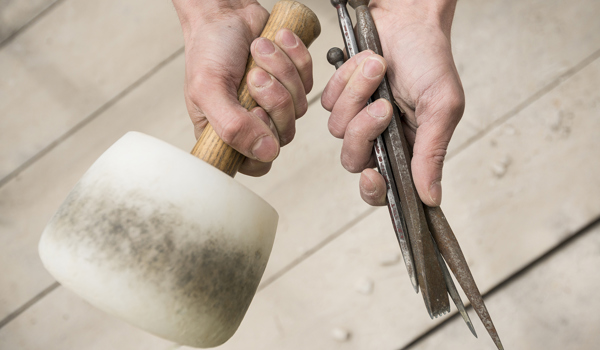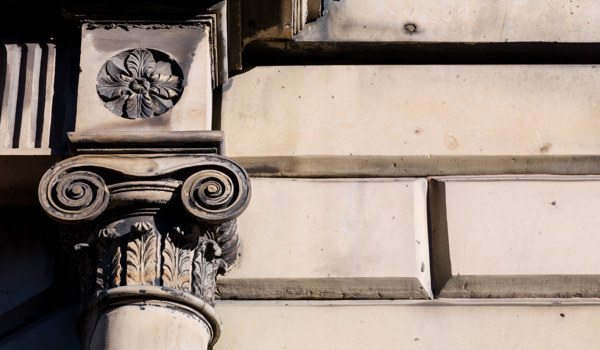- Home
- Building Advice
- Common problems
- How to repoint rubble masonry
How to repoint rubble masonry
Overview
Overview
A well-built rubble masonry wall is unlikely to need repointing for at least 100 years. If repointed properly, it should then last another 100 years without much further maintenance.
Repointing is necessary when the bedding or jointing mortar washes out and the stones start to become loose and at risk of falling out of place. It may also be necessary to halt the damaging effects of cement mortars, one of the common causes of problems with rubble pointing.
Lime mortars should be used for masonry repointing as they let the walls breathe. Careful mortar preparation is important, as is the thorough raking out of decayed mortar from the wall to make a sound base for the new mortar.
Care must be taken to replace missing pinnings (small stones) that have fallen out from between large stones. This should be done during the tamping stage to preserve both the wall’s structural strength and its appearance.
Detailed photographs should be taken before work begins of any sections to be dismantled and rebuilt. These provide a reference against which you can compare the finish and quality of new pointing with that of the original wall.
- Next
-
Characteristics of rubble masonry
Characteristics of rubble masonry
Characteristics of rubble masonry
Rubble stone masonry walls were traditionally built using a variety of pinnings (small stones) to make the larger stones secure in the wall. Both the large stones and pinnings were bedded, or set, in lime mortar (or sometimes clay).
A range of materials was used across Scotland to build rubble walls and to make them as structurally sound and as weatherproof as possible. As such, rubble walls vary greatly in appearance across regions according to the local materials and methods used to build them. How the lime mortar was applied is one such regional variation.
Lime mortar may:
- be flush with the stones
- be slightly recessed so that all of the stone faces can be easily seen
- have been gradually smeared over the faces of the rough stones so that the final finish appears almost as a full lime render
- feature extra lines of small stones embedded in it to give the wall added decoration
Pinnings shouldn't be removed or covered over, and missing or decayed pinnings should be replaced with new small stones. The structural integrity of a rubble masonry wall relies on both the large stones and the smaller pinnings placed next to them. Covering over pinnings will affect the appearance of a rubble masonry wall. Removing pinnings will affect both the wall's structural integrity and how it looks.
- Previous
-
Overview
- Next
-
Check your rubble masonry
Check your rubble masonry
Common causes of problems
Common causes of problems
Much superficial and inappropriate work has been carried out on rubble masonry over the last few decades. This won’t last as long as rubble stone walls built using the correct methods and the work will soon have to be redone.
Mortar used in the original construction of traditionally built rubble masonry will deteriorate over time and repointing work will eventually be necessary. But a wall that was correctly built in the first place is unlikely to need repointing for at least 100 years.
Failure of pointing
Repointing is necessary when the bedding or jointing mortar washes out and the stones start to become loose and at risk of falling out of place. Left as is, rainwater will easily reach the heart of the wall, promoting further deterioration. The wall may collapse if the problem isn’t fixed.
Plant growth can also damage pointing, particularly where roots enter the wall.
Cement mortar use
Cement mortars should not be used for repointing work as they can damage the stonework and interior finishes by trapping water inside the wall.
Lime based mortars should be used instead.
- Previous
-
Check your rubble masonry
- Next
-
Preparation for repointing
Preparation for repointing
Preparation for repointing
Lime mortar repointing work shouldn’t be carried out during periods of heavy rainfall or frost. A suitable covering may be needed to protect the work.
Take detailed photographs of the area to be repointed before work begins. You can then refer back to the wall’s original appearance and monitor the quality of the work over time against this benchmark.
- Previous
-
Common causes of problems
- Next
-
Raking out
Raking out
Raking out
Decayed mortar and any plant growth must be removed from the face of the wall and from around the stones. Only sound mortar should remain in the wall’s interior, to provide a good base for the replacement mortar.
Raking out is done with thin metal tools that can easily get in between the stones. Power tools should not be used.
Even small stones that become displaced during raking out should be carefully set aside for reuse in their original position in the wall. It's vital to replace missing pinnings for the sake of the wall's structural integrity.
Raked out areas should be carefully flushed out with water so that any last bits of loose and decayed mortar are washed down and off the wall face.
The space into which the new mortar must be placed should be about two to three times the width of the original joint. If the space is any smaller there won’t be enough room for the new mortar to set and perform properly.
Removing cement mortars
A hammer and chisel may be needed to remove cement mortars used to patch a wall in the past. Carefully chipping away the cement will expose the lime mortar beneath. Oscillating mechanical tools may also be used, but never rotary tools such as angle grinders. Avoid damaging the edges of underlying stones.
- Previous
-
Preparation for repointing
- Next
-
Dismantling
Dismantling
Dismantling
A very loose section of wall may need to be dismantled so that it can be rebuilt.
Before the section is taken down:
- A string grid should be held up to the wall.
- The stones should be numbered using chalk.
- Photos should be taken of the section.
- Stones should be removed and laid out relative to their position in the wall.
The affected section can then be rebuilt in the original arrangement using the grid and photos for reference.
- Previous
-
Raking out
- Next
-
Mortar preparation
Mortar preparation
Mortar preparation
Repointing mortar must be carefully made up, paying close attention to the exact quantities of the lime and sand materials used. This is so that further batches made of the mortar will possess the same qualities.
To use lime mortar correctly, it’s important to understand how it behaves and sets. Regional variations may exist in the mortar mix, and these should be copied so that look of the finished work matches the original.
Specialist analysis of the existing mortar can help to ensure that its replacement looks right and performs equally well. Using the mortar first on a trial panel is a good way to check how it will look before using it more widely.
- Previous
-
Dismantling
- Next
-
Tamping
Tamping
Tamping
Tamping is the process of pushing new mortar back into the heart, or core, of the wall.
Using appropriate tools, often a wooden rod, the new mortar should be pressed well into the spaces created by raking out. It should come into direct contact with the original mortar so that there are no voids in between.
The same mortar mix should be used for tamping and the final repointing.
Replacing missing pinnings
A wall’s appearance can be radically altered if pinnings (small stones) are missed out during the tamping process.
Recent repointing practices have tended to overlook the task of replacing the small stones, which is sometimes seen as overly time consuming. As a result, the volume of stone used in the wall is much reduced compared to the original build, and a similar volume of mortar is used to make up the difference.
This can give the false impression that:
- only large stones were used to build the original wall
- stones were surrounded by wide mortar joints
As well as creating the wrong appearance, this approach is a false economy. Using a larger amount of mortar means that more mortar is exposed to the weather, increasing the risk that it will decay quickly. The lifespan of the repointing work is thus much reduced when pinnings are missing.
- Previous
-
Mortar preparation
- Next
-
Pointing
Pointing
Pointing
Missing pinnings (small stones) or loose large stones should be put back into their original position, with all replaced stones making physical contact once more. This returns the wall to its full structural strength and original form.
Any remaining wide joints may signal that more pinnings are missing, and these should also be replaced as work proceeds.
The mason may have to use the wooden shaft of a hammer to drive the pinnings into the spaces between the large stones. This is safer than using the hammer head, as there’s a real risk that the metal could shatter the small stones and render them useless.
Repointing work should have a finish to match the wall’s original appearance. The surface finish and texture of the lime mortar is also important in achieving this.
To avoid an overly smooth finish, the surface of the mortar can be either:
- dabbed with a wet sponge while still setting
- gently stroked with a bristle brush while still setting
- scraped with an appropriate tool once it has firmed up
Pre-work photographs can help to recreate the:
- right appearance
- final joint size
- finish on the rough stonework
Special care must be taken to get the finish on the rough stonework right. Sometimes just a few extra millimetres of mortar thickness can lead to a wider surface finish than is needed to match the original.
- Previous
-
Tamping
Related to How to repoint rubble masonry

Hiring a contractor
Get advice on hiring a contractor including choosing a contractor and managing the work.




